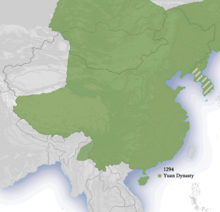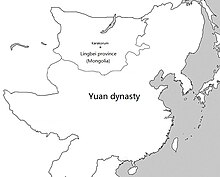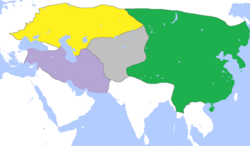Yuan dynasty in Inner Asia

The Yuan dynasty in Inner Asia was the domination of the Yuan dynasty in Inner Asia in the 13th and the 14th centuries. The Borjigin rulers of the Yuan came from the Mongolian steppe, and the Mongols under Kublai Khan established the Yuan dynasty (1271–1368) based in Khanbaliq (modern Beijing). The Yuan was a dynasty that incorporated many aspects of Mongol and Chinese political and military institutions.[1]
The Yuan directly ruled over most of modern China, Korea, Mongolia, and parts of Siberia (Russia). Specifically, the Yuan extended to Manchuria (modern Northeast China and Outer Manchuria), Mongolia, southern Siberia, the Tibetan Plateau and parts of Xinjiang. People from these 'Inner Asian' regions either belonged to the 'Mongol' class, 'Northern Han' class, or 'Semu' class.
In addition, the
Manchuria

Manchuria was originally ruled by the Han, Tang, Liao, and Jin dynasties before the emergence of the Mongol Empire in the early 13th century. During the Mongol conquest of the Jin dynasty (1211–1234), North China became ruled by Mongols, and Manchuria became part of the Yuan dynasty.
In 1269, the Yuan founder
According to
Mongolia

The ethnic Mongol rulers of the Yuan dynasty came from the Mongolian steppe, and Karakorum was the capital of the Mongol Empire until 1260.
During the Toluid Civil War, Mongolia was controlled by Ariq Böke, a younger brother of Kublai Khan. After Kublai's victory over Ariq Böke, Mongolia was put within the Central Region (腹裏) directly governed by the Central Secretariat at the capital Khanbaliq (Dadu). However, it was shortly occupied by Kaidu, leader of the House of Ögedei and de facto khan of the Chagatai Khanate during his war with Kublai Khan, although it was later recovered by the Yuan commander Bayan of the Baarin.
Temur was later appointed a governor in Karakorum and Bayan became a minister.
During the rule of Külüg Khan, the third Yuan emperor, Mongolia was put under the Karakorum province (和林行省; Helin Province) in 1307, although parts of Inner Mongolia were still governed by the Central Secretariat.
The province was renamed to the Lingbei province (嶺北行省) by his successor
Tibet

After the
]Besides modern-day Tibet Autonomous Region, the Yuan also governed parts of Sichuan, Qinghai and Kashmir. It was separate from the other provinces of the Yuan dynasty such as those of former Song dynasty, but still under the administrative rule of the Yuan.
One of the department's purposes was to select a dpon-chen ('great administrator'), usually appointed by the lama and confirmed by the Yuan emperor in Beijing.[3]
During the Yuan rule of Tibet, Tibet retained nominal power over religious and regional affairs, while the Yun managed a structural and administrative rule over the region,[4][full citation needed] reinforced by military intervention.
Yuan control over the region ended with the overthrow of the Yuan dynasty by the Ming dynasty, the revolt of Tai Situ Changchub Gyaltsen against the Mongols, and the Ming's establishment of relations with Tibet.[5]
Xinjiang
The Mongol Empire began to rule modern-day Xinjiang during their conquest of the Qara Khitai (Western Liao). After the division of the Mongol Empire and the established of the Yuan dynasty by Kublai Khan, Xinjiang became a battle place between the Yuan dynasty and the Chagatai Khanate.
Kublai attempted to subject Kaidu to an economic siege by entrenching his forces in the Tarim basin and over the Uyghurs, cutting him off from these resources. In 1276 he stationed a garrison in
The Yuan had shortly put most of present-day Xinjiang under its control under the Bechbaliq province (别失八里行省), but they were occupied by the Chagatai Khanate in 1286. After a long-time war between them, most of Xinjiang became under the control of the Chagatai Khanate, while the Yuan dynasty only retained control over the eastern part of Xinjiang. No province was set up again by the Yuan dynasty in Xinjiang, although the Yuan imperial court did set up an institution named Qara-hoja commandery "哈剌火州總管府" in eastern Xinjiang in 1330, which was directly governed by the Yuan dynasty. After the fall of the Yuan dynasty in 1368, the
Suzerainty over western khanates

The Yuan dynasty retained nominal political suzerainty over the whole Mongol Empire, including the three western khanates: the Golden Horde in Russia, the Chagatai Khanate in Central Asia and the Ilkhanate in Iran.
Khitan and Han Chinese administrators were sent to Bukhara and Samarqand to govern by the Mongols in the 1220s and this was witnessed by Qiu Chuji on his way to meet Genghis Khan in Afghanistan.[7] Chinese siege engineers were deployed in Iran and Iraq by the Ilkhanate.[8][9]
Han Chinese were sent to the Upper Yenisei valley as weavers, into Samarkand and Outer Mongolia as craftsmen as noticed by Ch'ang-ch'un in 1221-22 when he travelled to Kabul from Beijing and they moved to Russia and Iran. The Euphrates and Tigris basins were irrigated by Chinese hydraulic engineers and in 1258 at the siege of Baghdad one of Hulagu Khan's generals was Han Chinese. Because of the Mongols, Chinese influenced architecture, music, ceramics and Persian miniatures in the Golden Horde and Il-khan. Han Chinese, Mongols, Uighurs, Venetians and Geonese all lived in Tabriz were paper money was introduced and movable type printing and wood engraving as well as paper money, printed fabrics and playing cards spread from china to Europe due to the Mongols. wood engraving which was Chinese was mentioned in the 1313 book "Treasure of the Il-khan on the Sciences of Cathay" which was about Chinese medicine and translated by Rashid al-Din.[10]
The Khitan Yelü Chucai was sent by the Mongols to Central Asia[11][12]
Since the Toluid Civil War in the 1260s, the Mongol Empire over time politically fragmented into four khanates. Kublai Khan continued to hold the nominal title of Khagan and claimed the rule over the whole Mongol Empire, but he was unable to do so due to the disintegrated nature of the empire. The Berke–Hulagu war along with the Kaidu–Kublai war (1268–1301) that lasted a few decades accelerated this process.
After the death of
Around 1300,
In 1306, more fighting between Duwa and Chapar soon broke out over the question of territory. Temür backed Duwa and sent a large army under Khayisan in the fall of 1306, and Chapar finally surrendered. The territory controlled by Chapar was divided up by the Chagataids and the Yuan. The nominal supremacy of the Yuan, based on the same foundations as that of the earlier Khagans (even though there were continued border clashes among them), lasted until 1368, when the Yuan dynasty was replaced by the Ming dynasty in China.
Rashid al-din said that the Chinese millet grain known as tuki was brought by Han Chinese first to Marv in Turkmenistan and then to Iranian Azerbaijan in Khoy and Tabriz. Later Han Chinese were reported to be the most significant ethnicity generations later in Khoi around 1340 when Mustawfi wrote about them.[15]
The Tabriz based Rob'-e Rashidi and the Maraghe observatory in Ilkhanid Iran had scientists and scholars of Chinese origin. The "Book of Precious Presents or the Medicine of the Chinese People" (Tansuq-name ya tebb-e ahl-e Kheta) was translated by people working under Rashid-al-Din Fazl-Allah to Persian from Chinese and it was about Chinese medicine.[16][17]
The four khanates continued to interact with one another in the first half of the 14th century. They formed alliances, fought one another, exchanged envoys, and traded commercial products. In the case of the Yuan dynasty based in China and the Ilkhanate based in Iran, there was an extensive program of cultural and scientific interaction, while exercising extensive autonomy in the conduct of their internal affairs.[18] This also set an example for the later cultural and scientific interaction between the Ming dynasty in China and the Timurid Empire in Iran.
See also
- Administrative divisions of the Yuan dynasty
- Bureau of Buddhist and Tibetan Affairs
- Mongol invasions and conquests
- Division of the Mongol Empire
- Semu
- Han dynasty in Inner Asia
- Tang dynasty in Inner Asia
- Ming dynasty in Inner Asia
- Qing dynasty in Inner Asia
References
- ISBN 0-8061-2683-3.
- ^ Ars Orientalis: 9.
{{cite journal}}: Missing or empty|title=(help) - ISBN 9780700704743.
- ^ Wylie. p. 104.
To counterbalance the political power of the lama, Khubilai appointed civil administrators at the Sa-skya to supervise the mongol regency.
{{cite book}}: Missing or empty|title=(help) - ISBN 0-520-04383-9.
- ^ ISBN 978-1136800375.
- ^ Buell, Paul D. "Sino-Khitan Administration in Mongol Bukhara." Journal of Asian History, vol. 13, no. 2, 1979, pp. 121–51. Accessed 28 July 2022.
- ^ Raphael, Kate. "Mongol Siege Warfare on the Banks of the Euphrates and the Question of Gunpowder (1260-1312)." Journal of the Royal Asiatic Society, vol. 19, no. 3, 2009, pp. 355–70. JSTOR, Mongol Siege Warfare on the Banks of the Euphrates and the Question of Gunpowder (1260-1312) on JSTOR. Accessed 28 Jul. 2022.
- ^ Li, Chi Ch'ang (1888). The Travels of Ch'ang Ch'un to the West, 1220-1223 recorded by his disciple Li Chi Ch'ang. Translated by Bretschneider, E.
- ISBN 0521497817.
- ^ Schivatcheva, Tina (13 December 2017). ""Impressions of Early 13th century Central Asia as seen in the poetry of Yelü Chucai": a guest lecture by Dr. Sally Church with Prof. Qiu Jiangning". Joined-up History.
{{cite web}}: Missing or empty|url=(help) - ^ Ye-lü, Ch'u ts'ai (1888). Account of a Journey to the West (Si Yu Lu), 1219-1224. translated by E. Bretschneider.
- ISBN 0-521-80335-7.
- ^ Д.Цэен-Ойдов. Чингис Богдоос Лигдэн хутагт хүртэл 36 хаад.
- ISBN 052160270X.
- ISBN 978-0755617814.
- ISBN 1884964338.
- ^ Twitchett, Denis C.; Franke, Herbert; Fairbank, John King. The Cambridge History of China. Vol. 6. p. 413.

